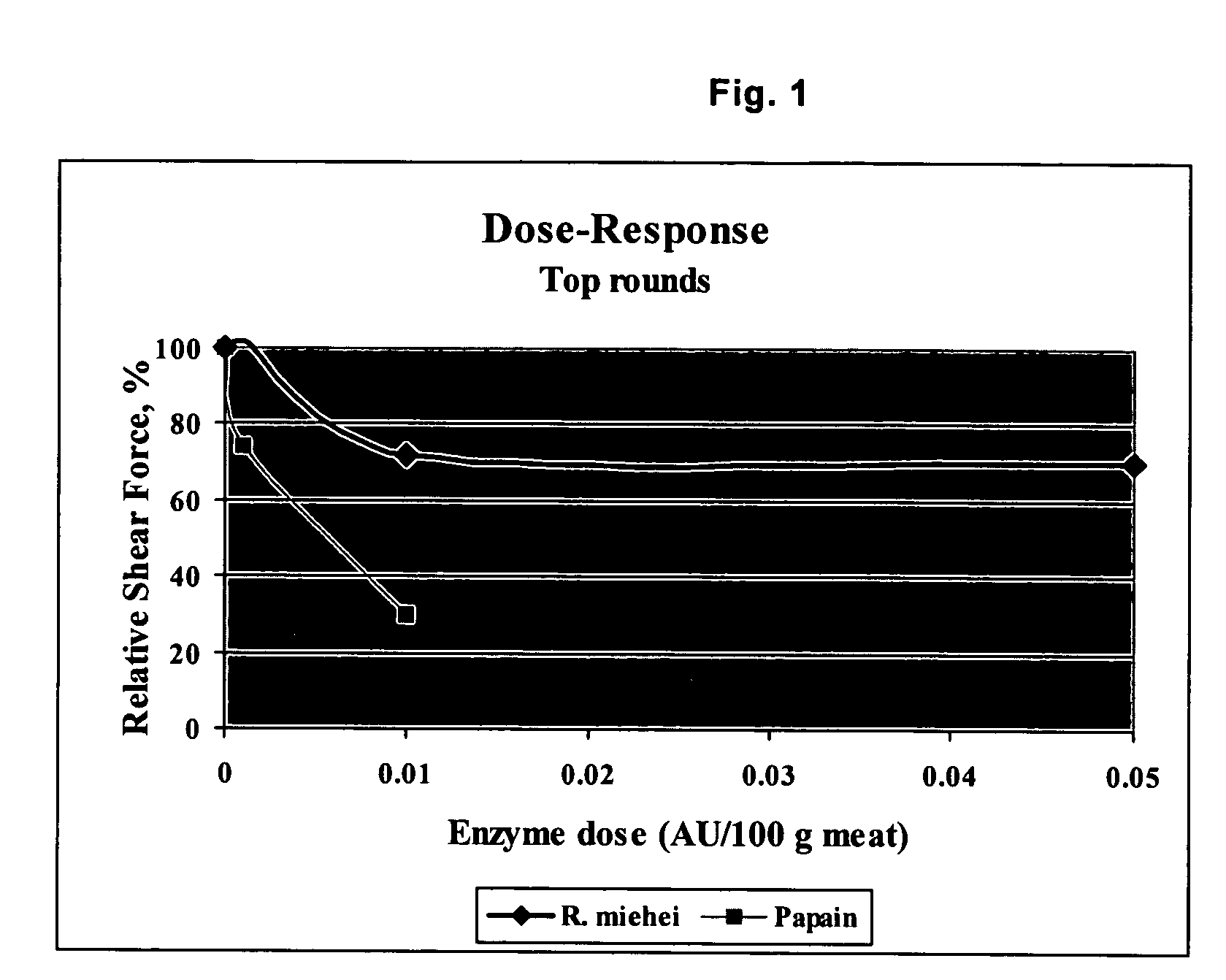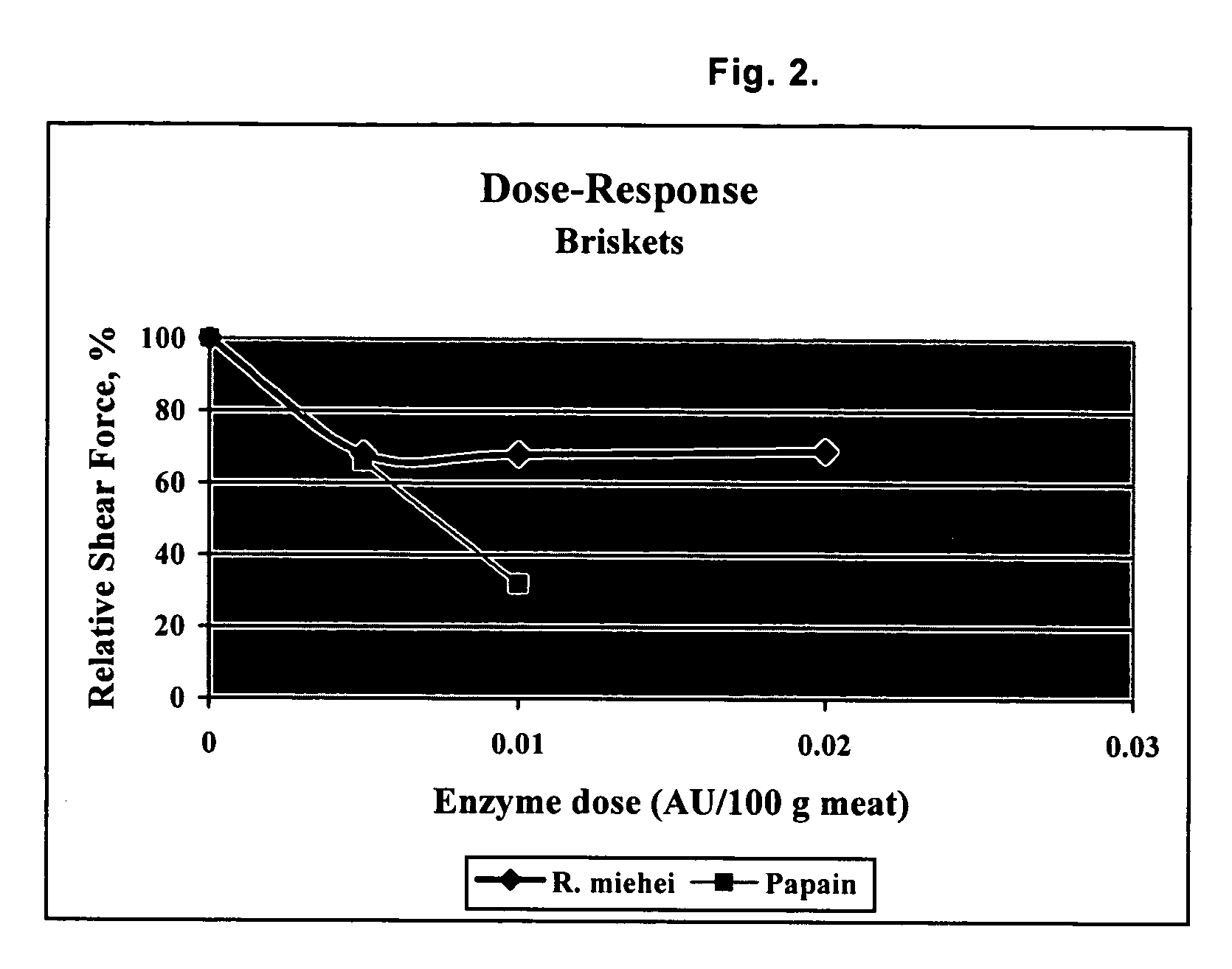Compositions and methods for tenderizing meat
a technology applied in the field of compositions and methods for tenderizing meat, can solve the problems of uncontrollable texture deterioration, over-tendering (i.e., mushy) products, etc., and achieve the effect of higher activity
- Summary
- Abstract
- Description
- Claims
- Application Information
AI Technical Summary
Benefits of technology
Problems solved by technology
Method used
Image
Examples
example 1
Activity on Individual Myofibrillar Proteins
The following experiment was performed to determine the activity of the R. miehei protease on the myofibrillar proteins. The experiment was performed by separately incubating the myofibrillar proteins troponin, myosin and actin for a period of 4 hrs with the protease at 37° C. At the end of the period, an aliquot of each sample was transferred into a Tris-glycine SDS sample buffer (Invitrogen Life Technologies) and heated at 85° C. for 5 min. Samples were then loaded onto precast gels for electrophoresis and the hydrolytic activity of the protease was evaluated by analyzing the protein bands.
As shown in Table 1 below, the protease hydrolyzed both troponin and myosin, however, no hydrolysis was observed on actin.
TABLE 1ProteinProteaseHydrolysisTroponin+YesTroponin−NoMyosin+YesMyosin−NoActin+NoActin−No
example 2
Measurement of Relative Hydrolytic Potential of a Protease for Collagen and Myofibrils
The following experiments was performed to evaluate the relative activity of papain and the R. miehei protease on each of the two major protein components of meat.
Collagenase Activity:
1. To 20 mg collagen from bovine tendon (Sigma) suspended in 3.8 ml Tris buffer (0.02 M Tris, 0.005 M CaCl2, pH 7.4) is added 200 μl collagenase (or protease) solution (1 mg / ml in Tris buffer) to make a total volume of 4.0 ml. 2. The mixture is incubated at 40° C. for 3 hr or 70° C. for 30 min. 3. The reaction mixtures are centrifuged in a microfuge for 10 min at 14,000 rpm. 4. 1.5 ml of supernatant is mixed with 4.5 ml of 5 N HCl and kept in a drying oven at 110° C. for 16 hrs (overnight) for complete hydrolysis of soluble peptides. 5. The hydrolysate is then analyzed for hydroxyproline content as follows:
Hydroxyproline Content: 1. The hydrolysate is diluted 25 times with distilled water. 2. To 1.00 ml ...
example 3
Meat Tenderization
Post-rigor beef (top rounds and briskets) were injected with varying concentrations of R. miehei protease and papain, and cooked to internal temperatures of 55° C., 65° C., and 75° C. (131° F., 149° F., and 167° F.). These temperatures correspond to “rare”, “medium” and “well done”, respectively.
Tenderness of meat treated was objectively measured using a Warner-Bratzler shear test. The Warner-Bratzler shear involves a 1 mm thick steel blade with a triangular hole cut from it. Downward movement of the blade (at a speed of 2 mm / s through a fixed distance of 30 mm) pushes the cored test sample into the V-shaped notch of the triangular hole and the maximum force required to cut through the sample gives an indication of sample (meat) toughness. Tenderness is inversely related to the maximum shear force.
As shown in FIGS. 1 and 2, both R. miehei protease and papain broke down the meat tissue resulting in increased tenderness (i.e., reduction of relative shear force)...
PUM
| Property | Measurement | Unit |
|---|---|---|
| diameter | aaaaa | aaaaa |
| length | aaaaa | aaaaa |
| speed | aaaaa | aaaaa |
Abstract
Description
Claims
Application Information
 Login to View More
Login to View More - R&D
- Intellectual Property
- Life Sciences
- Materials
- Tech Scout
- Unparalleled Data Quality
- Higher Quality Content
- 60% Fewer Hallucinations
Browse by: Latest US Patents, China's latest patents, Technical Efficacy Thesaurus, Application Domain, Technology Topic, Popular Technical Reports.
© 2025 PatSnap. All rights reserved.Legal|Privacy policy|Modern Slavery Act Transparency Statement|Sitemap|About US| Contact US: help@patsnap.com


